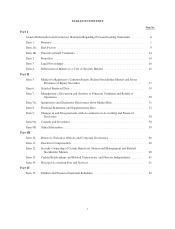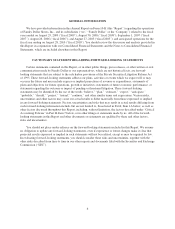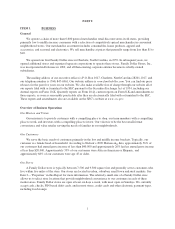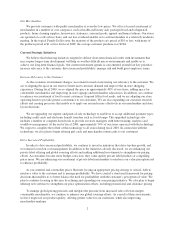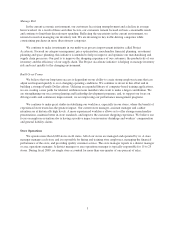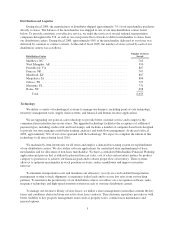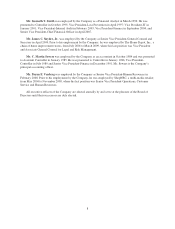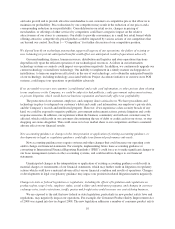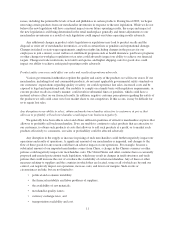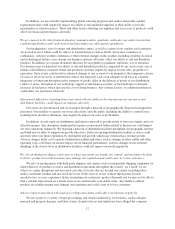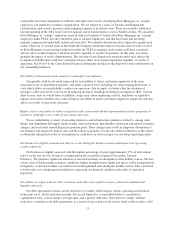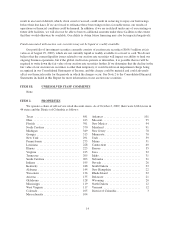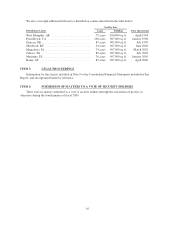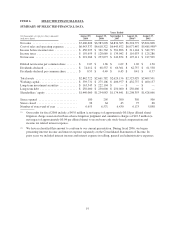Family Dollar 2009 Annual Report Download - page 17
Download and view the complete annual report
Please find page 17 of the 2009 Family Dollar annual report below. You can navigate through the pages in the report by either clicking on the pages listed below, or by using the keyword search tool below to find specific information within the annual report.
ITEM 1A. RISK FACTORS
The risks described below could materially and adversely affect our business, financial condition and results
of operations. We also may be adversely affected by risks not currently known or risks that we do not currently
consider to be material.
General economic conditions could impact our business adversely in various respects.
A further slowdown in the U.S. economy or other economic conditions affecting disposable consumer
income, such as employment levels, inflation, business conditions, fuel and energy costs, consumer debt levels,
lack of available credit, interest rates, and tax rates, may affect our business adversely by reducing overall
consumer spending or by causing customers to shift their spending to products other than those sold by us or to
products sold by us that are less profitable than other product choices, all of which could result in lower net sales,
decreases in inventory turnover or a reduction in profitability due to lower margins. The current global economic
uncertainty, the impact of recessions, and the potential for failures or realignments of financial institutions and
the related impact on available credit may impact our suppliers, our landlords, our customers and our operations
in an adverse manner including, but not limited to, our inability to readily access liquid funds or credit, increases
in the cost of credit, bankruptcy of our suppliers or landlords, and other impacts, which we are currently unable
to fully anticipate. At this time, we are unable to determine the impact on our customers and our business, if any,
of programs adopted by the U.S. government to stabilize and support the economy.
Our profitability is vulnerable to cost increases, inflation, and energy prices.
Future increases in our costs such as the cost of merchandise, shipping rates, freight and fuel costs, and store
occupancy costs may reduce our profitability. These cost changes may be the result of inflationary pressure that
would further reduce our sales or profitability. Increases in other operating costs including changes in energy
prices, wage rates and lease and utility costs may increase our costs of goods or operating expenses and reduce
our profitability. For example, increases in the cost of diesel fuel will likely result in an increase in transportation
costs, which will increase our overall operating costs and possibly lower profitability.
Our growth is dependent upon our ability to increase sales in existing stores and the success of our new store
opening program.
Our growth is dependent on both increases in sales in existing stores and our ability to open profitable new
stores. Increases in sales in existing stores are dependent on factors such as competition, merchandise selection,
store operations and customer satisfaction. If we fail to realize our goals of successfully managing our store
operations and increasing our customer retention and recruitment levels, our sales may not increase and our
growth may be impacted adversely. Our ability to open profitable new stores depends on many factors including
our ability to identify suitable markets and sites for new stores, negotiate leases with acceptable terms, gain name
recognition in the new markets and successfully compete against local competition, while managing expenses
and costs. Unavailability of attractive store locations, delays in the acquisition or opening of new stores, delays or
costs associated with remodeling existing stores, delays or costs resulting from a decrease in commercial
development due to capital constraints, difficulties in staffing and operating new store locations, and lack of
customer acceptance of stores in new market areas all may impact our new store growth negatively and the costs
or the profitability associated with new or remodeled stores.
We operate in a highly competitive environment and, as a result, we may not be able to compete effectively or
maintain or increase our sales, market share or margins, particularly if the prolonged global economic
conditions intensify.
We operate in the highly competitive discount retail merchandise sector with numerous competitors, some
of which may have greater resources than us. We compete for customers, merchandise, real estate locations and
employees. This competitive environment subjects us to various risks, including the ability to continue our store
9


